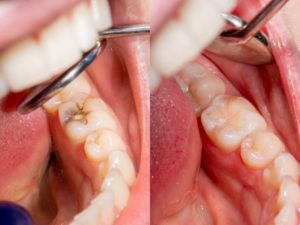
Cavities are one of the most common oral health problems, and they don’t only occur because you consume too much sugar. Other causes include dental accidents, poor oral hygiene, and even using your teeth to bite down on hard surfaces. Cavities are the first stage of tooth decay and can become a serious threat to your oral health if left untreated. Fortunately, they are easily treated with dental fillings before significant damage occurs. Keep reading to learn from your dentist in Casper about some signs you may need a filling.
What Are Indications a Dental Filling is Necessary?
Most cavities don’t cause symptoms during the early stages of development which is why regularly visiting your dentist is critical for early detection. However, if you notice any of the following signs, you should contact your dentist immediately as they could indicate that a cavity is progressing.
Bad Breath
Does food frequently get stuck between certain teeth? You can develop bad breath from food debris that gets lodged in these small spaces. The small gap or opening will require a filling to close.
Damage to an Older Filling
A filling can become damaged or loose after eating something hard. You may be able to see or feel that it has become dislodged. If you notice an existing filling is broken, cracked, or lost, you need to replace it immediately before the cavity worsens.
Tooth Sensitivity
If this is a new sensation that occurs when eating hot or cold foods, it could indicate worn enamel and developing cavities. The sensitivity could be isolated to one area and may also occur with sweet, sticky, or sour foods.
A Toothache or Sharp Pain
A persistent, throbbing pain is one of the most common indicators of a cavity. It can happen when you bite down or chew your food. You may also experience sharp pain when consuming foods with extreme temperatures. If the pain becomes more frequent or severe, contact your dentist right away.
Dark Spots or a Hole in Your Tooth
A noticeable cavity will look like a dark spot or hole in your tooth. Once the cavity becomes large enough, you may be able to feel the hole with your tongue or finger. At this point, the cavity may have worsened significantly, and you should see your dentist immediately for a filling.
What Are Types of Dental Fillings?
Not all dental fillings are created equally. Here are the different types:
- Composite Resin: This type is increasingly popular because they have the same color as natural teeth. They are the obvious choice to restore teeth visible when a person smiles or opens their mouth. The maximum lifespan is five years.
- Amalgam: This used to be the most popular type of filling. They are made from a mixture of predominantly mercury, as well as copper, zinc, tin, and silver. This can be a viable option to restore teeth at the back of the mouth. The maximum lifespan is 10 years.
- Gold: Typically made from a mixture of gold and other metals, they are often used to make onlays and inlays. The lifespan can exceed 15 years.
When you suspect you have tooth decay, it’s time to contact your dentist in Casper about a filling. Fortunately, good oral hygiene can go a long way to help protect you from cavities.
About the Author
Dr. Erin Prach has been working hard for smiles in Casper since opening her practice in 2015. She earned her dental doctorate from the University of Colorado. Dr. Prach capitalized on the opportunity to study oral surgery while she was on a mission trip in Guatemala. If you ever require dental fillings, she only needs one short appointment to place a tooth-colored filling for you made of composite resin. You can schedule an appointment on her website or by calling (307) 337-4770.
